

35 Psychological Tricks To Help You Learn Better. Have you ever considered letting your students listen to hardcore punk while they take their mid-term exam?

Decided to do away with Power Point presentations during your lectures? 8 Things Everybody Ought to Know About Concentrating. “Music helps me concentrate,” Mike said to me glancing briefly over his shoulder.

Mike was in his room writing a paper for his U.S. History class. On his desk next to his computer sat crunched Red Bulls, empty Gatorade bottles, some extra pocket change and scattered pieces of paper. In the pocket of his sweat pants rested a blaring iPod with a chord that dangled near the floor, almost touching against his Adidas sandals. On his computer sat even more stray objects than his surrounding environment. The Research Behind 20% Time. Since experimenting with “20% Time” in my class a few years ago, I’ve been fascinated by the research and history of this practice in education and the business world.

This has led me down a long road to finally writing a book (to be published by Routledge) on inquiry-driven education and 20% time. Designing 20% Time in Education. A.J.
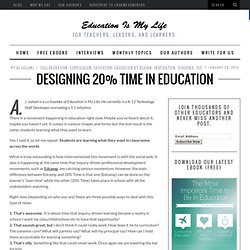
Juliani is a co-founder of Education Is My Life. He currently is a K-12 Technology Staff Developer overseeing a 1:1 initiative. There is a movement happening in education right now. Maybe you’ve heard about it, maybe you haven’t yet. 6 Principles Of Genius Hour In The Classroom. Genius Hour In The Classroom: 6 Principles Of Genius Hour by Terry Heick Update: We did a t-shirt campaign of this graphic last year and it sold decently (if 13 t-shirts can be considered ‘decent.’).

It’s still available if you wanted a t-shirt with a kind of learning model on it. You know. If you’re into that sort of thing. Give your students 20% time to do whatever they want. "Seriously? You're going to let us do whatever we want for 20% of our time in English class? " "I'm skeptical. " Measuring student progress, in session. Design Thinking for Educators. Design thinking is a mindset. It is the confidence that everyone can be part of creating a more desirable future, and a process to take action when faced with a difficult challenge. That kind of optimism is well needed in education. Classrooms and schools across the world are facing design challenges every single day, from teacher feedback systems to daily schedules. Wherever they fall on the spectrum of scale – the challenges educators are confronted with are real, complex, and varied. And as such, they require new perspectives, new tools, and new approaches.
Design thinking is a mindset. Classrooms and schools across the world are facing design challenges every single day, from teacher feedback systems to daily schedules. Design Thinking for Educators. Teacher Resources. Learning pages. Collaborate Across Teams, Silos, and Even Companies - Rebecca Newton. By Rebecca Newton | 11:00 AM July 25, 2014 Everywhere I turn right now, I hear leaders talking about their need for collaborative leadership.
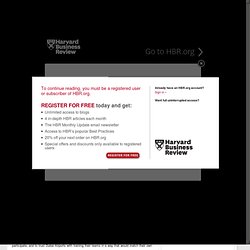
It’s being identified as the fundamental differentiator in achieving strategic objectives. In order to make a difference though, it has to go beyond the polite, thoughtful behaviours of involving others, sharing information and lending strength when it’s needed. I define real collaborative leadership as: facilitating constructive interpersonal connections and activities between heterogenous groups to achieve shared goals. It is proactive and purpose-driven. Dubai Airports offers a case study. A Useful Framework For Transparency In Education.
A Useful Framework For Transparency In Education by TeachThought Staff Transparency in education is important for a variety of reasons.

Increasingly teachers are encouraged to work in professional learning communities, data teams, and other structures intended to encourage teachers to work together to unpack standards, plan instruction, assess learning, analyze data, revise instruction, re-analyze data, and then evaluate the impact of individual teaching strategies. The idea of both vertical alignment (i.e., same content area, different grade level) and horizontal alignment (same content area, same grade level) both depend greatly on visibility–what’s being taught, when, and how. 6 Design Principles Of Connected Learning. The Learning And Design Principles Of Connected Learning by Terry Heick In 2015, no one should be hurting for compelling ed content.
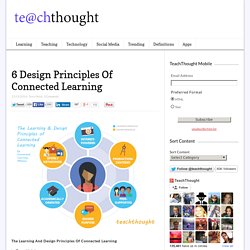
Sites like edutopia, The Tempered Radical, Langwitches, Justin Tarte, Cool Cat Teacher, Grant Wiggins’ blog, and dozens of others offer outstanding reading on a daily basis to help you improve the things that happen in your classroom. (And this list is frustratingly incomplete–they’re just the sites on my radar that I’ve been reading since I entered education.) 35 Psychological Tricks To Help You Learn Better. Making Friends With Failure. No one likes failure, the F-word, no matter how you sugarcoat it.
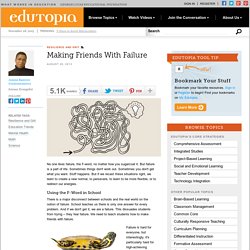
But failure is a part of life. Sometimes things don't work out. Sometimes you don't get what you want. Stuff happens. But if we recast these situations right, we learn to create a new normal, to persevere, to learn to be more flexible, or to redirect our energies. Curry.virginia.edu/uploads/resourceLibrary/CASTL_practioner_Part3_single.pdf. Curriculum_Resources. Project Based Learning.
6 Principles Of Genius Hour In The Classroom. A comparison of the effects of problem-based learning and lecturing on the development of students' critical thinking - Tiwari - 2006 - Medical Education. A Jigsaw Lesson Strategy. Jigsaw Strategy The jigsaw lesson strategy is one where students work together as a team to learn material.
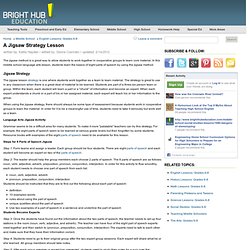
The strategy is great to use in any classroom when there is a great deal of material to be learned. Students are part of a three-six person team or group. Within the team, each student will learn a part or a "chunk" of information and become an expert. When each expert understands a chunk or a part of his or her assigned material, each expert will teach his or her information to the group. When using the jigsaw strategy, there should always be some type of assessment because students work in cooperative groups to learn the material. Language Arts Jigsaw Activity Grammar seems to be a difficult area for many students. Steps for 8 Parts of Speech Jigsaw Step 1: Form teams and assign a leader. Step 2: The leader should help the group members each choose 2 parts of speech. Blended Learning. Coached Through College: Professional Motivators Decrease Dropout Rates.
When she became the first person in her family to graduate from college, Virginia Hughes invited the three people she credited most with getting her to that milestone: her mother, her grandmother and a retired hospital administrator named Laura Harrill. Even though she’d been a perfect stranger until Hughes’s senior year in high school, Harrill helped her navigate the shoals of paperwork, financial issues and personal dramas that prevent many students from ever getting into, let alone completing, college. “I consider her an extension of my family,” said Hughes, of Maryville, Tenn., who graduated from Pellissippi State Community College in Knoxville and is now pursuing a bachelor’s degree in anthropology at the University of Tennessee. “Even if I had a bad day and just needed somebody to talk to, I knew she’d be there.”
Elearning. Flipped Classroom. Game of knowing. Goal Resources. Guided Inquiry graphic. Helping Students Become More Self-Regulated Learners. Innovation. Inspiring Innovative Learners with Genius Hour / 20% Time. Making Friends With Failure. Metacognition, Feedback and Scaffolding. Neurology. Pedagogy. Problem-based learning: future challenges for educational practice and research - Dolmans - 2005 - Medical Education.
Reflection and reflective practice in health professions education: a systematic review. Self monitoring strategies. Self-Directed Learning in Problem-Based Learning and its Relationships with Self-Regulated Learning. Self-regulated learnning. Student learning strategies, mental models and learning outcomes in problem-based and traditional curricula in medicine, Medical Teacher, Informa Healthcare. Original Student learning strategies, mental models and learning outcomes in problem-based and traditional curricula in medicine 2006, Vol. 28, No. 8 , Pages 717-722 (doi:10.1080/01421590601105645)
Twenty Tips for Managing Project-Based Learning.